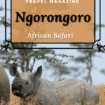
Editor’s Note: We’re all dreaming of travel ahead. Here’s some inspiration for future adventures. We share places, products and activities we recommend. If you make a purchase using a link on our site, we may earn a commission.
Standing on the precipice, gazing over the vast depression of the Ngorongoro Crater in northern Tanzania, in Africa, the enormity of our task immediately struck us.
At dinner the previous night our safari guide, Anwad told the group, “I can’t promise you we’ll see a rhino. I hope we do, but I can’t promise”.
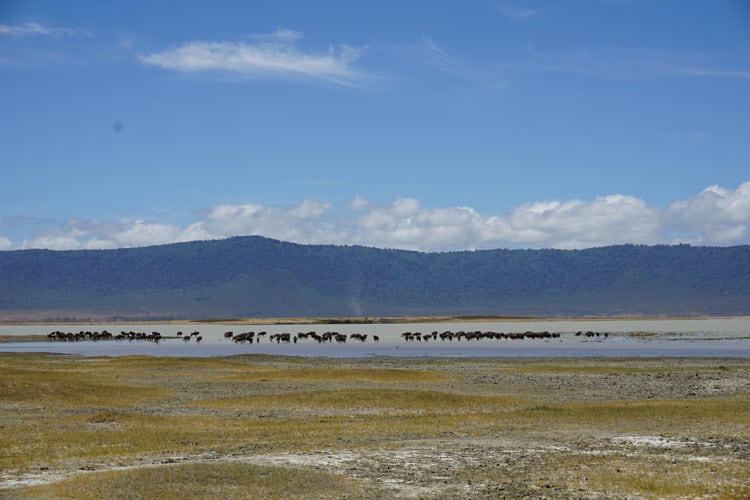
Africa’s Garden of Eden
Formed millions of years ago when a massive volcano erupted and collapsed in on itself, the caldera of the Ngorongoro crater is 610 meters deep and covers an area of 260 square kilometers.
Known as ”Africa’s Garden of Eden” it is the largest intact, inactive and unfilled volcanic caldera in the world and it is teeming with wildlife, including a population of 50 critically endangered black rhinoceros. Forget about needles and haystacks, catching a glimpse of one of Ngorongoro’s most famous residents represent another kind of impossible.
When the volcano collapsed all those years ago, the cauldron did not flood. The destruction of the volcano created a wide-ranging landscape of marsh, lake, savannah, salt pan and forest. The ecosystem, produces enough food for the diverse African wildlife in the area to live year-round in ecological harmony.
The list of Ngorongoro’s inhabitants is staggering; cheetahs, elephants, hippopotamus, buffalo, Thompson and Grant’s gazelle, hyenas and the highest density of lions anywhere in the world.
But arriving at the entrance to the park, it’s no secret who the star of the show is.
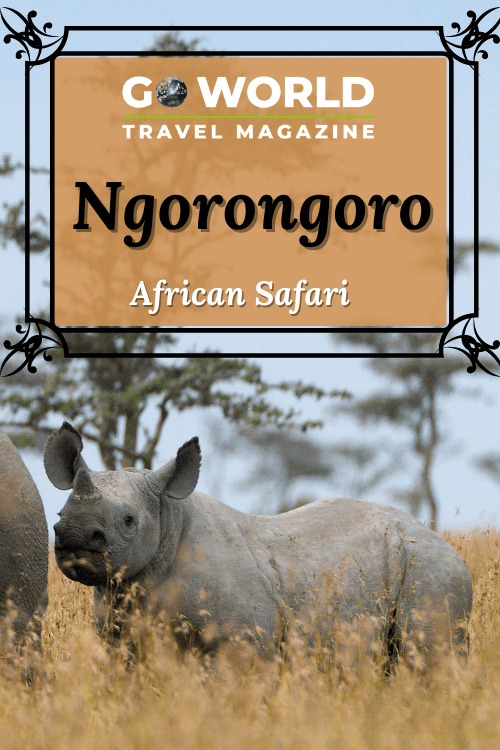
A Bumpy Ride into the Crater of Ngorongoro
Black rhinos adorn the walls of the park’s large green gate; one even appears on the park’s crest.
The main road in the Ngorongoro Conservation Area circles the rim of the crater and is surrounded on both sides by thick rainforest. The same brown dirt that covers the road is dusted on the leaves of the forest.
The sky is cloudy and the air crisp as we embark on the hour-long drive to the gate where we will descend into the crater. On the way, we see a smattering of wildlife such as zebras and wildebeest.
As we reach the Seneto gate and the road that descends directly into the crater, the morning clouds clear and the temperature steadily increases. It’s getting unbearably hot, but our excitement outweighs any discomfort.
Be prepared for any type of weather on a nature excursion like this with Sierra Trading Post. Find shorts, hats and layers for cooler or sunny days. Check out the outdoor outfit selection here.
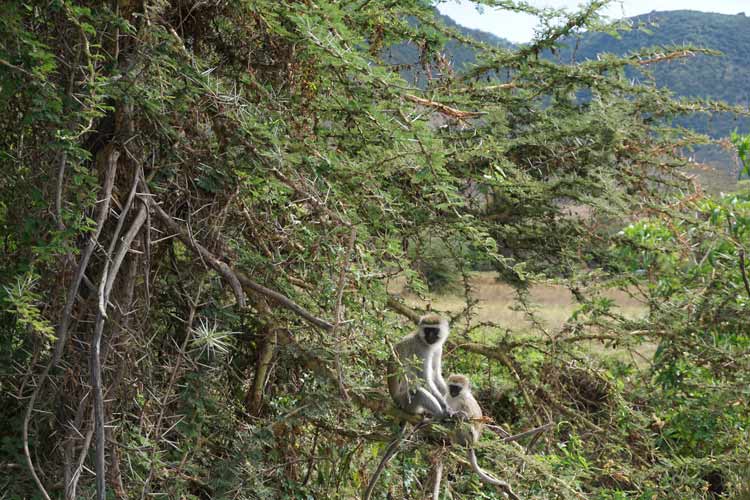
On Safari in Tanzania
A line of safari jeeps slowly creeps down into the crater, bouncing around the occupants as they desperately try to capture the awesome views with their cameras.
Green gives way to dry yellow and light brown, and the dust that covered the foliage of the rainforest takes on a dryer tone and texture. Small tornados of dust known as dust devils rise in the distance. A solitary warthog burrows around a green spot a hundred meters from the road.
The dusty grassland stretches out endlessly in front of us, encircled by the forest-covered slopes of the caldera. With the sporadic dust devils and the shimmering heat haze, it feels as if we are in the middle of a simmering cauldron.
As we stand taking photos, two curious zebras look on while wildebeest below in the background. The crater is home to tens of thousands of wildebeest, so their calls are the dominant sound to be heard, a distinctive “murping” that echoes across the natural amphitheater.
The wildebeest and zebras are always seen together and form a symbiotic relationship providing protection in numbers and a lack of competition for food. Zebras eat long grass while the wildebeest prefer short.
Protecting the Black Rhino in Tanzania
As we take in the unfamiliar surroundings, our guide Anwad, a slight man in his fifties with a playful glint in his eye, explains to us the efforts that go into protecting the park’s black rhinos.
They are under 24-hour surveillance by rangers and cameras, and every movement is tracked and logged. They must be vigilant as poachers decimated the crater’s population of black rhino’s in past decades. Although the value of rhino horn has fallen in recent years, it is still worth thousands of dollars on the black market.
Conservation efforts have seen their numbers double in the last 30 years. It began in the 1990s when Tanzania declared war on poachers and began conservation programs that included the reintroduction of black rhinos into Ngorongoro.
Lake Magadi is a crucial body of water for the fauna of Ngorongoro and a renowned habitat for large flocks of pink flamingos.
You can see more of the conservation efforts around the area on the Serengeti and Ngorongoro: 2-Night 3-Day Camping Safari. Book your dates in advance here and cancel anytime up to 24-hours before for a full refund.
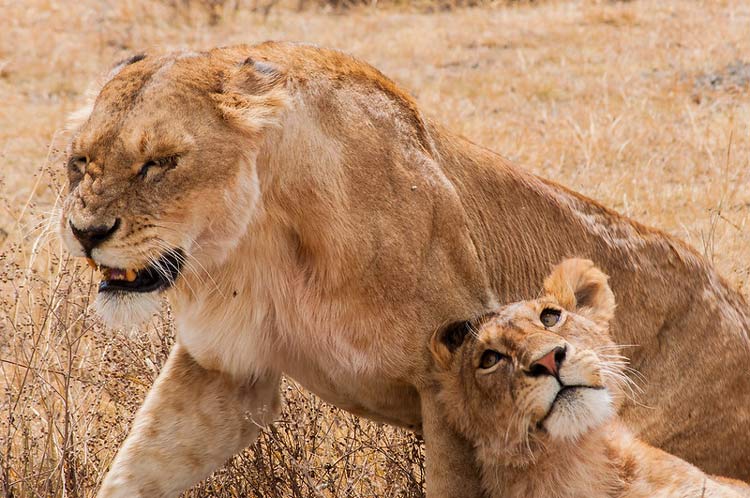
Lions and Wildebeest
As we drive along the lakeside, we spot a pride of lions. The males are lounging by the water, but the females don’t appear so relaxed. Positioned in long tufts of grass ten meters from the water’s edge they scan the area. A massive herd of wildebeest is slowly making its way to the water as the Lions look on attentively.
Anwad begins to get excited as we pull onto the side of the road. He explains that the wildebeest will come to drink in large waves for protection.
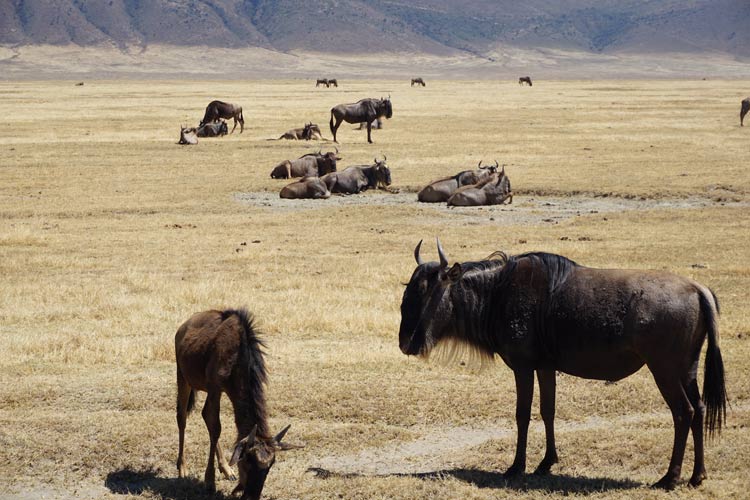
The female lions watch the approaching wildebeest closely, and as the second wave draws near, they begin to get animated.
One of the males moves to cover his exposed back in some long grass. Male lions rarely get involved in a hunt, leaving the work to the females of the pride. More safari jeeps pull over, jostling for the best position to watch the unfolding drama.
The female lions are primed to spring into action as the third wave of wildebeest edge closer to the trap. The bellowing of the wildebeest grows louder; they sense something. Some hold their position while others drink around 50 meters from the trap.
Lions don’t have the stamina for a prolonged chase, so they usually only attack when prey is 30 meters or less. The wildebeest go no farther, and the lions stand down. Anwad looks disappointed. The realization dawns on the baying tourists that there will be no hunt to witness. The jeeps depart one by one.
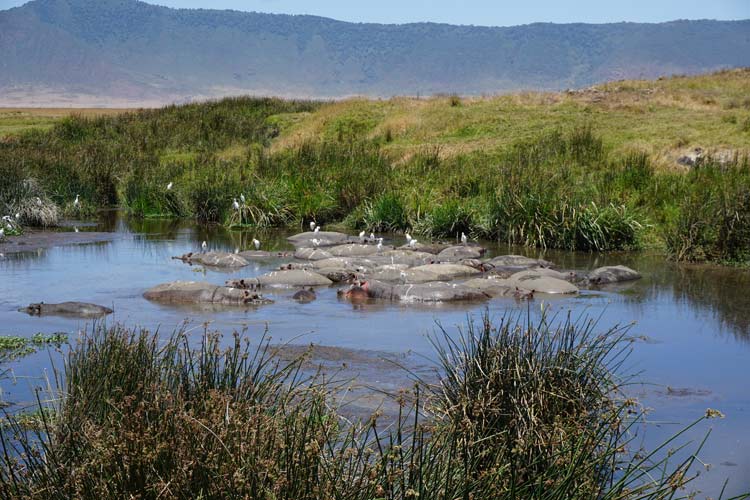
Hippos in Ngorongoro
We drive through the open plains for three hours, occasionally stopping to observe the wildlife.
Pods of hippos wallow in the mud of a watering hole, splattered with the white droppings of oxpecker birds. Their ears flicker rapidly as they surface through the muddy water, their heads draped with tangles of weeds.
A jackal scampers through the bush, stopping every few meters to dig up insects. Our guide informs us we are heading to our lunch spot, a watering hole home to a family of hippos is a mere 30 minutes’ drive away.
Suddenly Anwad stops the jeep and stands on his seat, binoculars raised to his eyes. He is looking to our left, but all we can see is a couple of ostriches lumbering by. The heat haze makes it difficult to see anything clearly but there, a few kilometers in the distance is what looks like a black spot.
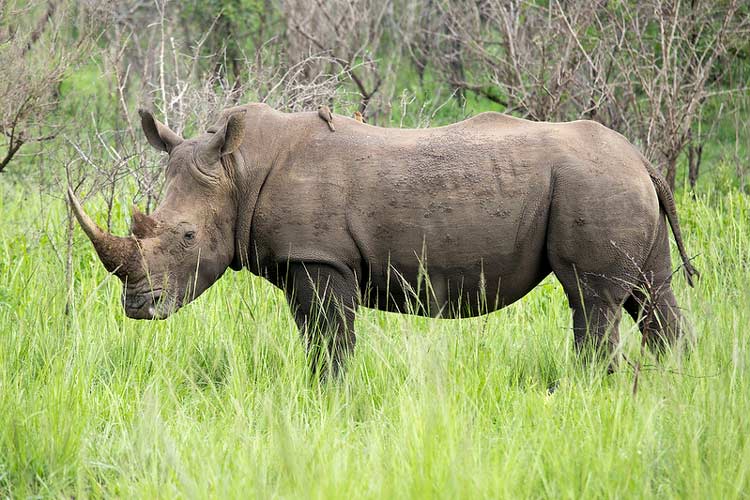
The Notorious Black Rhino in Tanzania
“That’s one of them, there on the horizon,” Anwad announces as he passes the binoculars. The excitement builds up as each of us waits for our turn. I take the binoculars and focus as much as I can on the dot on the horizon. The rhino is so far away that the binoculars don’t enhance the view that much, but sure enough, I can make out the profile of something substantial with a horn attached.
Everyone in the jeep is awash with a sense of giddy excitement and relief. There is a relief because despite all the wonderful nature witnessed today, to miss out on seeing the park’s most famous residents on our safari would have felt like a defeat.
It may only be a shadow in the distance, but standing in this foreign world looking at the mysterious beast brought back from the brink of extinction is a humbling experience. Thinking of the plight of Tanzania’s black rhinos, I am reminded of Dr. Richard Leakey, the famous archaeologist involved in the discovery of some the earliest human remains just an hour’s drive west of Ngorongoro.
Dr. Leakey said, “To save an animal’s life in order that it may suffer indefinitely is something I would never condone.”
Black rhinos are notoriously shy creatures, and human interaction has been their burden and savior. I stare at the black dot on the shimmering horizon, and just as suddenly as it appeared, the silhouette blends into the background and disappears.
There is silence in the jeep as we drive on. No, we didn’t get close enough to witness its immense build or look in its eyes, it appeared as a spec on the horizon, but given the trials and tribulations of this fantastic beast, we’ll take it.
Book This Trip
Time to start planning your wild adventure to Ngorongoro? First, you’ll want to check out the best airline deals and travel hacks through Kiwi. Next, you can get prepared for the journey by finding local restaurant favorites and other interesting sites to see through Travelocity and TripAdvisor.
- More helpful links:
- Tanzania Travel Guide
- Redwood Expeditions
- Tanzania Tourist Board
- Ngorongoro Conservation Area Authority
Author Bio: Journalism and communications provide the opportunity to always keep readers interested with engaging writings and captivating narratives. I have spent over five years working in media relations and communications for international NGO’s focused on conservation, global health and international disarmament. As a journalist, I have covered politics, culture and art and travel. My writings aim to inform in an honest and accurate way.
Check out Mick Storey’s Webpage.

